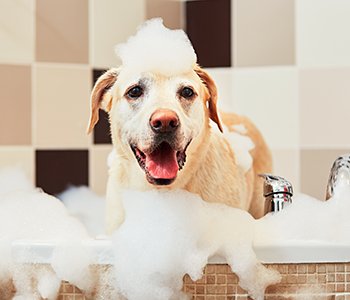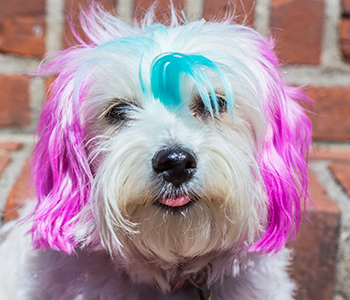According to the American Pet Products Association, Americans spent about $70 billion on their furry, feathered, and scaly family members in 2017. Of that amount, roughly $7 billion (or 10%) was for grooming products, services, and boarding.1
It’s part of being a responsible parent to make sure our pets are kept clean and well-groomed. But how safe are commercial pet products, really? Better yet, what are the alternatives if you want to keep your pet looking good and staying healthy?
Your Dog or Cat is More Sensitive Than You to Harsh Chemicals
We all know the names of some pretty awful stuff found in the commercial soaps made for humans. The list for pet shampoos is similar. The only difference is that these chemicals can hurt your dog or cat even more.
One obvious issue is that dogs and cats like to lick themselves – a lot. Whatever residue remains on your pet’s fur after a bath will eventually wind up in their digestive system, and thus their internal organs. This includes harmful chemicals which may lead to conditions like cancer.
Secondly, dogs and cats are more sensitive to these substances than humans are. This has to do with how their internal organs work and the makeup of their skin.
Your pet’s skin has a different pH than yours does. While human skin pH hovers around 4 to 5.5, dogs and cats normally maintain a skin pH of about 7.0 to 7.2 (the pH of their fur is slightly lower).2
All mammals, including humans, also have what is called an “acid mantle” – a protective layer of acidic oil that covers the top layer of skin. Human shampoos are designed with the human mantle and pH in mind.3 Most human soaps and shampoos will wash off this mantle to a degree, but it will be reestablished in about 10 to 12 hours.
Therefore, it is important to keep your shampoos and soaps separate from your pet’s: you have your body cleaning products and pets have theirs. A telltale sign that you may be using the wrong kind of cleanser for your pet is the development of irritated, flaky, or dry skin.
The Lowdown on Pet Shampoos: 5 Ingredients to Avoid

Here are just a few ingredients to avoid when you are shopping for pet products:
#1 – “Proprietary Blends.” If you see vague language like this instead of actual ingredients, move on. Other eyebrow-raising terminology may be “special formula,” “signature blend,” or a weblink.
#2 – Artificial colors, flavors, or fragrances. These vague references could mean anything from petroleum-based substances to waste products that are reused to save money. Many artificial fragrance chemicals won’t be listed on ingredient labels directly. A typical ingredient is styrene, which the National Toxicology Program deemed as “reasonably anticipated to be a human carcinogen” in 2011.4 Phthalates are another set of harmful substances often used in commercial fragrances. Phthalates are known hormone disruptors that can lead to reproductive cancers in both humans and pets.
#3 – Preservatives. The term “preservative” could mean anything from formaldehyde and sodium benzoate to parabens. Whatever the source, they are bad news for you and your pet. They are also something to which almost everyone is exposed. A U.S. Center for Disease Control and Prevention survey found that out of 2,500 urine samples, 99% had detected levels of methyl paraben.5 Isothiazolinone preservatives have also been linked to neurotoxic effects.
#4 – Sodium Lauryl Sulfate, Sodium Laureth Sulfate, or Ammonium Laureth Sulfate. All three of these chemicals are surfactants, used in hundreds of human and pet products. Unlike other chemical substances, which may be processed in the liver more quickly, these tend to stay in the internal organs for up to a week. This enhances the risk of complications to the brain, liver, and heart. Sodium laureth sulfate in particular has been linked with contamination with dioxane,6 a known carcinogen.
#5 – Mineral oil. Adding mineral oil to the list of ingredients to avoid may seem strange. After all, it is a natural substance that helps moisturize dry skin. That sounds like a good thing, right? Not where your pet is concerned. Slathering mineral oil on your dog, or using a product that contains it, will interfere with your pet’s naturally produced oils, which are specifically designed to protect your pet from specific pathogens.
Of course, this is just a short list of substances to look out for. Be sure to talk to your holistic veterinarian and do your own research when it comes to your pet’s unique sensitivities and needs.
NEVER Use Human Hair Dyes as Dog Hair Dyes!

Additionally, studies over the last 40 years have confirmed that commercial hair dyes can be highly toxic to humans as well. A 2004 study at Oxford University8 found a direct correlation between long-term use of dark, permanent hair dyes and adult acute leukemia.
Is it Really Natural Dog Shampoo?
According to an analysis by the market research firm Packaged Facts, “natural” pet food sales reached over $8 billion in 2016. Natural pet food sales grew by 12% between 2012 and 2016.9
This growth means that there are more products to choose from for your pet at the health food store, but it doesn’t mean that you can trust everything you see on the shelf. Manufacturers find clever ways to skimp on quality, and some of their tactics are outright misleading.
Among specific ingredients to watch for is Cocamide MEA, a foaming agent. This substance is coconut oil-based, and thus is often used in natural pet products (as well as human products). Cocamide MEA is anything but natural, however. It has been linked to carcinogenic nitrosamines,10 according to the U.S. Federal Drug Administration (FDA).11
Another chemical closely linked to Cocamide MEA is triethanolamine. It should also be avoided.
The sad fact is that the safety and efficacy of pet grooming products is not a topic that most veterinarians learn about in school, primarily because they get very little training on basic health maintenance concepts at all.12 Sound familiar?
This means that it is up to you as a pet parent to do your homework and make sure the products you are using are as pure as possible. When it comes to pet grooming products, safe ones will get your dog or cat squeaky clean, while being sure to do no harm.





















Leave a Reply